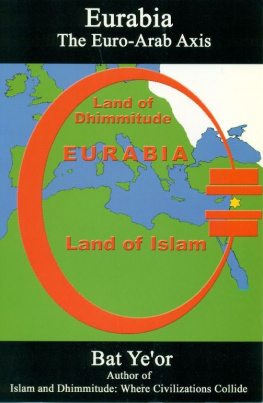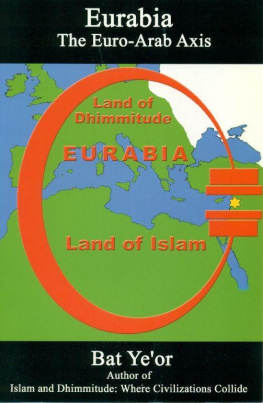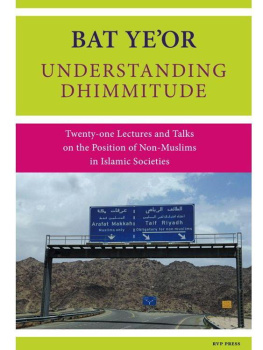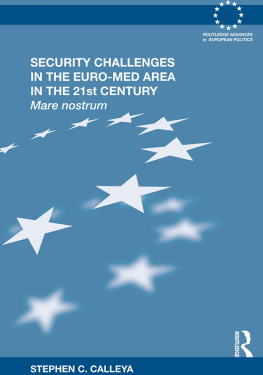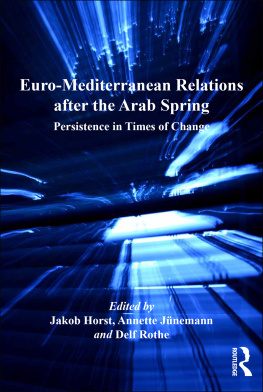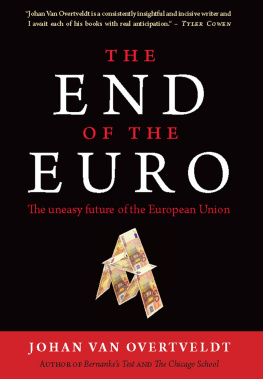Yeor - Eurabia: the Euro-Arab Axis
Here you can read online Yeor - Eurabia: the Euro-Arab Axis full text of the book (entire story) in english for free. Download pdf and epub, get meaning, cover and reviews about this ebook. City: Madison, year: 2005, publisher: Fairleigh Dickinson University Press, genre: Politics. Description of the work, (preface) as well as reviews are available. Best literature library LitArk.com created for fans of good reading and offers a wide selection of genres:
Romance novel
Science fiction
Adventure
Detective
Science
History
Home and family
Prose
Art
Politics
Computer
Non-fiction
Religion
Business
Children
Humor
Choose a favorite category and find really read worthwhile books. Enjoy immersion in the world of imagination, feel the emotions of the characters or learn something new for yourself, make an fascinating discovery.
Eurabia: the Euro-Arab Axis: summary, description and annotation
We offer to read an annotation, description, summary or preface (depends on what the author of the book "Eurabia: the Euro-Arab Axis" wrote himself). If you haven't found the necessary information about the book — write in the comments, we will try to find it.
Yeor: author's other books
Who wrote Eurabia: the Euro-Arab Axis? Find out the surname, the name of the author of the book and a list of all author's works by series.
Eurabia: the Euro-Arab Axis — read online for free the complete book (whole text) full work
Below is the text of the book, divided by pages. System saving the place of the last page read, allows you to conveniently read the book "Eurabia: the Euro-Arab Axis" online for free, without having to search again every time where you left off. Put a bookmark, and you can go to the page where you finished reading at any time.
Font size:
Interval:
Bookmark:
Eurabia
The Euro-Arab Axis
By the Same Author
Les Juifs en Egypte. Geneva: Editions de lAvenir, 1971. Revised and enlarged Hebrew edition: Yehudai Mizrayim. Foreword by Hayyim Zeev Hirschberg. Translated from the French by Aharon Amir. Tel Aviv: Maariv, 1974.
Le Dhimmi: Profil de lopprim en Orient et en Afrique du Nord depuis la conqute arabe. Paris: Editions Anthropos, 1980.
The Dhimmi: Jews and Christians under Islam. Revised and considerably enlarged English edition. Preface by Jacques Ellul. Translated from the French by David Maisel, Paul Fenton, and David Littman. Rutherford, NJ: Fairleigh Dickinson University Press, 1985. (Seventh printing, 2005.)
Ha-Dimmim: Bnai Hasoot. Enlarged Hebrew edition. Translated by Aharon Amir. Preface by Jacques Ellul. Introduction by Moshe Sharon. Jerusalem: Cana, 1986.
The Dhimmi: Jews and Christians under Islam. Russian edition. In 2 vols. Jerusalem: Society for Research on Jewish Communities / Aliyah Library, 1991.
Les Chrtients dOrient entre Jihd et Dhimmitude, VIIe-XXe sicle. Preface by Jacques Ellul. Paris: Les Editions du Cerf, 1991.
The Decline of Eastern Christianity under Islam. From Jihad to Dhimmitude. Seventh-Twentieth Century. With a Foreword by Jacques Ellul. Translated from the French by Miriam Kochan and David Littman. Madison, NJ: Fairleigh Dickinson University Press, 1996 (Fifth printing, 2005.)
Juifs et Chrtiens sous lIslam: Les dhimmis face au dfi intgriste. Paris: Berg International, 1994. (Second printing, 2005.)
Der Niedergang des orientalischen Christentums unter dem Islam. German edition. With a preface by Heribert Busse. Translated from the French and English by Kurt Maier. Munich: Resch Verlag, 2002.
Islam and Dhimmitude: Where Civilizations Collide. Translated from the French by Miriam Kochan and David Littman. Madison, NJ/Fairleigh Dickinson University Press, 2002. (Third printing, 2005.)
Eurabia: lAxe Euro-Arabe. Paris: Jean-Cyrille Godefroy, 2006.
Eurabia
The Euro-Arab Axis
Bat Yeor
Madison Teaneck
Fairleigh Dickinson University Press
2005, 2006 by Bat Yeor
All rights reserved. Authorization to photocopy items for internal or personal use, or the internal or personal use of specific clients, is granted by the copyright owner, provided that a base fee of $10.00, plus eight cents per page, per copy is paid directly to the Copyright Clearance Center, 222 Rosewood Drive, Danvers, Massachusetts 01923. [0-8386-4076-1/05 $10.00 + 8 pp, pc.]
Associated University Presses
2010 Eastpark Boulevard
Cranbury, NJ 08512
The paper used in this publication meets the requirements of the American National Standard for Permanence of Paper for Printed Library Materials Z39.48-1984.
Library of Congress Cataloging-in-Publication Data
Bat Yeor.
Eurabia: the Euro-Arab axis / Bat Yeor.
p. cm.
Includes bibliographical references and index.
978-0-8386-4307-5
1. EuropePolitics and government20th century. 2. EuropePolitics and government21st century. 3. IslamInfluence. 4. Islam and stateEurope.
5. Jihad. I. Title.
D1053.B38 2005
303.48240174927dc22 2004025171
SEVENTH PRINTING 2006
(with new )
Contents
To David, my companion in life and work
Broad historical movements that profoundly transform human societies are difficult to discern in the short term. They extend over decades, often centuries, and affect the social fabric in multiple ways that are scarcely noticed by contemporary commentators but become perceptible in times of accelerated social change. This pattern of historical development applies to the dynamic of Islamic jihad. For over a millennium, jihad has been a potent political force that has subjugated and in some cases extinguished once powerful centers of Judeo-Christian, Hindu, Buddhist and other civilizations in Asia, Africa, and Europe. This historical process can be observed today on all three of these continents. In the 1970s, jihad reappeared as a powerful factor in European affairs but, for nearly three decades, the revival of jihad passed with little comment in both popular and academic journals. European statesmen remained silent. The murderous September 11, 2001 jihadist attacks in America broke the silence. President Bushs war on terrorism forced Europeans to take sides, while investigations revealed the presence of extensive and well-established networks of jihad terrorists throughout Europe. The Madrid bombing of March 11, 2004 heightened awareness of this grim reality. However, constructive public debate has been hampered by profound ignorance of the jihad dynamic and by the tendency of Europes political elite to continue to appease jihadist driving forces.
This book describes Europes evolution from a Judeo-Christian civilization, with important post-Enlightenment secular elements, into a postJudeo-Christian civilization that is subservient to the ideology of jihad and the Islamic powers that propagate it. The new European civilization in the making can be called a civilization of dhimmitude. The term dhimmitude comes from the Arabic word dhimmi. It refers to subjugated, non-Muslim individuals or people that accept the restrictive and humiliating subordination to an ascendant Islamic power to avoid enslavement or death. The entire Muslim world as we know it today is a product of this 1,300 year-old jihad dynamic, whereby once thriving non-Muslim majority civilizations have been reduced to a state of dysfunctional dhimmitude. Many have been completely Islamized and have disappeared. Others remain as fossilized relics of the past, unable to evolve.
For over a millennium, following the seventh-century Muslim military offensives against Byzantium, European powers instinctively resisted jihadmilitarily when necessaryto protect their independence. The response of postJudeo-Christian Europe of the late twentieth century has been radically different. Europe, as reflected by the institutions of the EU, has abandoned resistance for dhimmitude, and independence for integration with the Islamic world of North Africa and the Middle East. The three most apparent symptoms of this fundamental change in European policy are officially sponsored anti-Americanism, antisemitism/anti-Zionism and Palestinianism. These increasingly visible aspects of European policy are merely components of an overall vision for the transformation of Europe into a new geopolitical entityEurabia.
The decisive shift in European policy came as a result of the oil crisis of 1973 when the European Economic Community (EEC), at the initiative of France and the Arab League, established the Euro-Arab Dialogue (EAD). Since then, the EAD has been in the vanguard of engineering a convergence between Europe and the Islamic states of North Africa and the Middle East. The EAD promotes a specific conception of international politics that determines Europes relations with the Arab/Muslim world, and with America and Israel. It has also formulated a vision of European history, religion and culture, both past and future. Under the rubric of dialogue, the EEC and its Arab League partner created a formidable political and legal superstructure that encompasses the entire Euro-Arab relationship and fostered increased joint Euro-Arab diplomatic initiatives.
The following chapters describe the origin and development of the little-known EAD. EEC and subsequently EU documents reveal the development of a new ideology that is producing demographic and cultural change for the purpose of creating conditions for the fulfillment of the Eurabian vision. Eurabias cultural preconceptions include the new Judeophobia, as well as resurgent anti-Americanism. The intensity of Judeophobia and anti-Americanism reflects increasing Islamic penetration of Europe and its growing influence on European policy. Judeophobia has been a characteristic of European and Islamic societies since medieval times. The Islamic elements of the modern European Judeophobia, together with its related anti-Americanism, have been incorporated into policies emerging from the EAD. They are as much anti-Christian and anti-Western as they are anti-Jewish. I do not believe that Judeophobia and anti-Zionism are common among the majority of Europeans. These attitudes, instead, are imposed
Next pageFont size:
Interval:
Bookmark:
Similar books «Eurabia: the Euro-Arab Axis»
Look at similar books to Eurabia: the Euro-Arab Axis. We have selected literature similar in name and meaning in the hope of providing readers with more options to find new, interesting, not yet read works.
Discussion, reviews of the book Eurabia: the Euro-Arab Axis and just readers' own opinions. Leave your comments, write what you think about the work, its meaning or the main characters. Specify what exactly you liked and what you didn't like, and why you think so.

